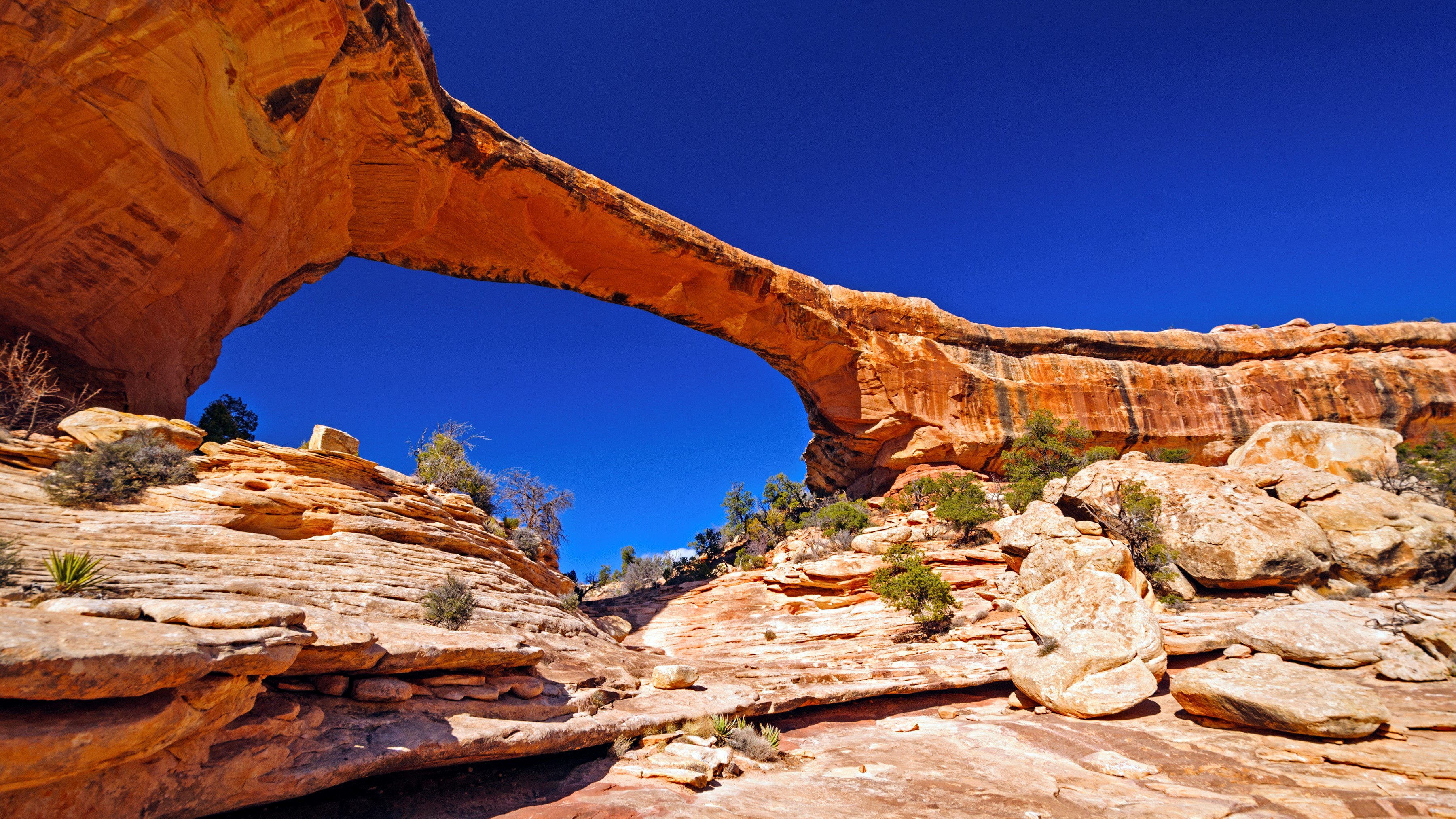'Ring of fire' from US national parks: 7 great places to see the annular solar eclipse 2023
From Oregon to Texas, clear skies are likely for the first annular solar eclipse in the U.S. since 2012. Here are the best scenic spots for catching a spectacular view.

On Oct. 14, 2023, an annular solar eclipse will be visible in parts of the Americas, and some of the best places to view it will be in the scenic U.S. Southwest, including many national parks.
Beginning in Oregon at 9:13 a.m. PDT and ending in Texas at 12:03 p.m. CDT, the path of the solar eclipse will cross over a dozen U.S. national parks, national monuments and other beautiful spots, including Oregon's Crater Lake, Utah's Bryce Canyon and Arizona's Monument Valley.
With low humidity and historically good chances of clear skies in these locations, this spectacular event — the first annular, or "ring of fire," solar eclipse to be visible in the U.S. since 2012 — is a great excuse to travel, especially because many of the best viewing locations are also International Dark Sky Parks.
Related: When is the next solar eclipse?
Bear in mind, however, that mid-October is shoulder season when many national parks empty out and campsites close. The path of the eclipse also passes over high-elevation regions, mainly the Colorado Plateau, where temperatures at night can drop to freezing (or lower) that time of the year.
Use maps of the eclipse path to double-check that your intended exact location will see a "ring of fire" and will have a clear view of the sun and moon at the exact time of the eclipse. (This interactive Google Map has links to PeakFinder in its pop-up boxes, or PhotoPills.) However, because the eclipse will be relatively high in the southeastern sky after it leaves Oregon and California, getting an unobstructed view will not be a major problem for most observers.
So, get yourself a national park annual pass, grab a pair of solar eclipse glasses and go chase a ring of fire!
Breaking space news, the latest updates on rocket launches, skywatching events and more!
Solar eclipses are dangerous if you do not observe the sun safely.
Never look at the sun without proper eye protection. It is never safe to look directly at the sun's rays even if the sun is partly obscured because they contain harmful ultraviolet (UV) and infrared (IR) rays that can damage your eye's retina and even cause blindness.
Never use regular sunglasses to observe the sun. The only safe way to look directly at the sun is through specifically designed solar filters, using solar eclipse glasses for direct viewing and solar filters for telescopes and binoculars.
Crater Lake National Park, Oregon
Witnessing an annular solar eclipse lasting 4 minutes, 23 seconds while surveying the deepest lake in America is an enticing prospect, but it won't be as easy as it first appears. For starters, Crater Lake National Park is at an altitude of 6,178 feet (1,883 meters), and by mid-October, early snowfall could close the North Entrance, West Rim Drive and East Rim Drive (both were closed on Oct. 14, 2016, though they've been open in the years since.)
You'll have to take your chances, but if it is accessible and clear, then you could stand on Watchman Peak (or Watchman Trailhead) to see the eclipse 19 degrees above Wizard Island in the lake. Even if those roads are closed, Rim Village Visitor Center will remain accessible, from where you'll see the ring of fire above Garfield Peak. Or, you could attempt the 3.5-mile (5.6 kilometers) Garfield Peak Hike for a view from 8,054 feet (2,455 m). Either way, you'll have to drive in that day, because Mazama Campground closes in late September and Crater Lake Lodge closes in early October. Oct. 14 at Crater Lake National Park has been cloudy on this day 41% of the time since 2000.
Eclipse at 9:17 a.m. PDT on Oct. 14, 2023, 19 degrees above the southeast horizon.
Lava Beds National Monument, California
Lava Beds National Monument, in northeastern California, is famous mostly for the 700 caves that wind their way through hardened lava flows. But if you plan to see the "ring of fire" from this location, you'll have to do more than simply avoid being underground. The southern edge of the path of annularity cuts right through the park, with the visitor center and the only campground at Indian Well (43 sites; first come, first served) out of the path. In fact, the longest ring of fire will last just 54 seconds at the entrance sign to the north.
A better plan would be to head slightly east to Captain Jack's Stronghold (where the ring of fire will last 1 minute, 9 seconds) or the Wildlife Observation Point (1 minute, 37 seconds). However, for maximum time with the ring of fire, consider viewing slightly to the north, where the Volcanic Legacy Scenic Byway meets Highway 29 (2 minutes, 39 seconds). Oct. 14 at Lava Beds National Monument has been cloudy on this day 33% of the time since 2000.
Eclipse at 9:19 a.m. PDT on Oct. 14, 2023, 20 degrees above the southeast horizon.
Great Basin National Park, Nevada
An International Dark Sky Park, the vast Great Basin National Park in the Snake Range, in Nevada, holds astronomy program days, hosted by dark-sky rangers, on Saturday nights in October, which may work well for the eclipse. There are no firm plans so far, but a viewing event in the Astronomy Amphitheater is possible. In the summer, solar viewing events are often staged on the back porch of the Lehman Caves Visitor Center.
Other viewing spots for the eclipse include Mather Overlook and Wheeler Peak Overlook (both 3 minutes, 46 seconds) in the north of the park. The nearby (likely empty) Sevier Lake — a short drive east on Highway 50 — is on the centerline (4 minutes, 37 seconds). Oct. 14 at Great Basin National Park has been cloudy on this day 35% of the time since 2000.
Eclipse at 9:24 a.m. PDT on Oct. 14, 2023, 27 degrees above the southeast horizon.
Bryce Canyon National Park, Utah
Although you could get a slightly longer view of the ring of fire from the turnoff from Highway 12 to enter Bryce Canyon National Park (2 minutes, 59 seconds), easily the most scenic location would be the world-famous Bryce Amphitheater (2 minutes, 31 seconds), where any kind of light-play on the hoodoos below could be a beautiful sight.
However, there are also places you don't want to be during the eclipse, such as the shadowed Wall Street Trail. (Though do hike after the eclipse, because Bryce's trails are gorgeous; don't miss the Peek-A-Boo Loop Trail.) As a bonus, Bryce Canyon is an International Dark Sky Park and has the longest-running night-sky program in the national park system. Astronomy events are usually held at the visitor center (which will see a ring of fire for 2 minutes, 40 seconds). Bryce Canyon National Park has been cloudy on this day 23% of the time since 2000.
Eclipse at 10:27 a.m. MDT on Oct. 14, 2023, 30 degrees above the southeast horizon.
Natural Bridges National Monument, Arizona
If you want to mix the eclipse with natural rock arches the best place to head is Natural Bridges National Monument. You could hike the 12-mile full loop trail or tour the Bridge View Drive and take your pick from the Kachina, Sipapu and Owachomo Bridges (4 minutes, 27-29 seconds throughout). There's a first-come, first-served campground next to the visitor center with 13 spots. Visitors will also experience the first International Dark Sky Park in the world, which was created in 2007. Natural Bridges National Monument has been cloudy on this day 23% of the time since 2000.
Eclipse at 10:29 a.m. MDT on Oct. 14, 2023, 31 degrees above the southeast horizon.
Monument Valley Navajo Tribal Park, Arizona
Although not technically a U.S. national park or national monument, Monument Valley Navajo Tribal Park (4 minutes, 16 seconds) is one of the most scenic places in the country to visit. Expect large crowds for this event, although there are plenty of places to stay and camp in the vicinity. Monument Valley Navajo Tribal Park has been cloudy on this day 21% of the time since 2000.
Eclipse at 10:29 a.m. MDT on Oct. 14, 2023, 31 degrees above the southeast horizon.
Padre Island National Seashore, Texas
If you want the longest view of a ring-of-fire solar eclipse possible, there's only one place to be. Sixty-six miles (106 km) of wild coastline along the Gulf of Mexico, Texas' Padre Island National Seashore is a narrow barrier island and the last intact coastal prairie habitat in the U.S. Visit Whitecap Beach at its northern end, and the rare view will last 4 minutes, 52 seconds. However, there is one drawback: Padre Island National Seashore has been cloudy on this day 65% of the time since 2000.
Eclipse at 11:56 a.m. CDT on Oct. 14, 2023, 49 degrees above the south-southeast horizon.
Additional resources
Want to look further ahead? You can find a concise summary of solar eclipses out to 2030 on NASA's eclipse website. Read more about solar and lunar eclipses on Eclipse Wise, a website dedicated to predictions of eclipses, and find beautiful maps on eclipse cartographer Michael Zeiler's GreatAmericanEclipse.com and interactive Google Maps on Xavier Jubier's eclipse website. You can find climate and weather predictions by meteorologist Jay Anderson on Eclipsophile.com.

Jamie is an experienced science, technology and travel journalist and stargazer who writes about exploring the night sky, solar and lunar eclipses, moon-gazing, astro-travel, astronomy and space exploration. He is the editor of WhenIsTheNextEclipse.com and author of A Stargazing Program For Beginners, and is a senior contributor at Forbes. His special skill is turning tech-babble into plain English.






